To adapt your home for vision or hearing impairments, focus on environmental modifications like contrasting colors on stairs and doorways, adding tactile markers to switches and appliances, and securing cords to prevent trips. Improve visibility with proper lighting and task lighting, and highlight hazards with reflective tape. Install tactile cues, clear signage, and accessible safety devices such as talking alarms. Keep fixtures well-marked and simple to guarantee safety and independence—exploring these options can make your space much more accessible.
Key Takeaways
- Use contrasting colors on stairs, doorframes, and edges to improve visibility and prevent trips.
- Install tactile markers, textured labels, and high-contrast signage for easy identification of controls and hazards.
- Incorporate bright, reflective tape and proper lighting to enhance visibility in low-light conditions.
- Add tactile cues such as textured stickers and raised bumps on appliances and switches for navigation assistance.
- Implement accessible safety devices like talking alarms, sensor-activated lighting, and tactile controls for safety and independence.
Making Your Space Safer With Environmental Modifications
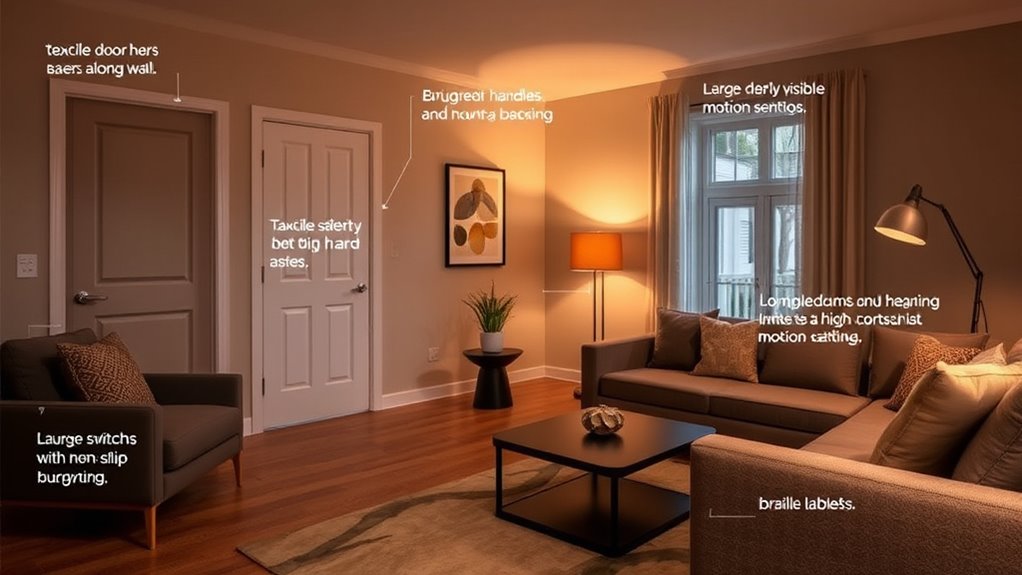
Have you considered how small environmental changes can make your home much safer for someone with vision or hearing impairments? Implementing contrasting colors on stairs, doorframes, and edges improves visibility and helps prevent trips. Adding tactile markers, like textured stickers or raised bumps on appliances and switches, allows easy identification for those with visual impairments. Using high contrast visuals in your home environment further enhances safety and orientation for individuals with sensory impairments. Incorporating environmental modifications such as enhanced lighting and tactile cues can significantly improve navigation and independence. Securing cords against walls and out of walkways reduces tripping hazards and creates a safer environment. Using bright, reflective tape on steps, thresholds, and hazards enhances visibility, especially in low light. Installing non-slip mats under rugs or on smooth surfaces prevents slipping and tripping. Additionally, consulting sensory impairment guidelines can provide more comprehensive safety strategies tailored to specific needs. Incorporating automation technologies such as voice-activated controls can also assist individuals with impairments by reducing the need for physical interaction with devices. Moreover, integrating auditory cues like chimes or alerts can further support those with hearing impairments in navigating their environment safely.
Enhancing Visibility Through Lighting and Contrast
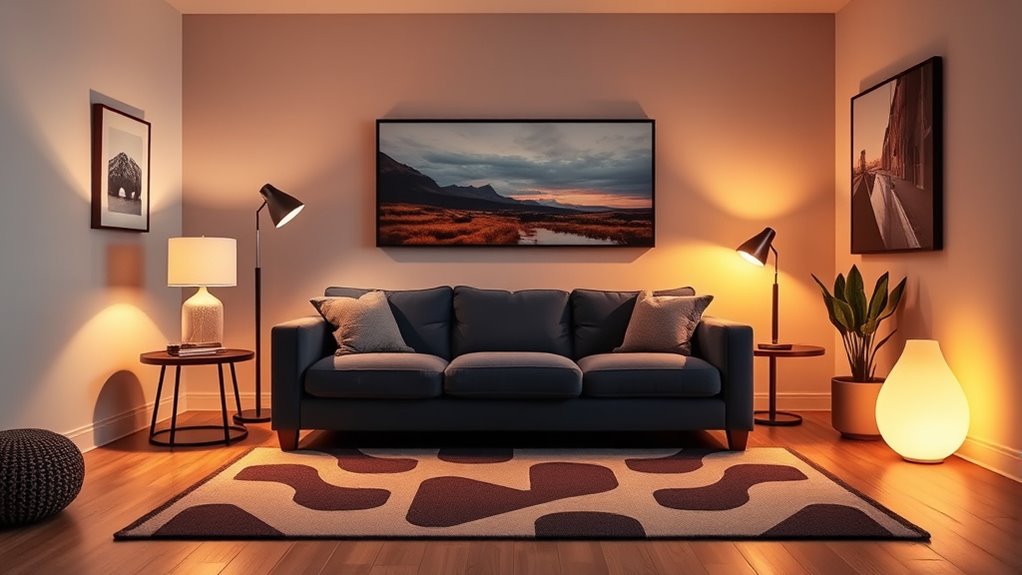
Enhancing visibility through lighting and contrast is essential for creating a safer, more navigable home for individuals with vision impairments. Proper lighting levels reduce shadows and improve visual clarity, making it easier to see details. In addition, understanding ethical hacking principles such as risk assessments and vulnerability identification can be applied to evaluate and improve home safety measures effectively. Incorporate task lighting in areas like kitchens and bathrooms to provide focused illumination. Using contrast colours on walls, door frames, switches, and furniture helps differentiate objects and architectural features, improving visibility. Matte finishes on surfaces minimize glare and reflections that can hinder sight. Highlight edges of stairs, doorways, and steps with contrasting tape or paint to prevent trips. Well-placed light sources and contrasting markings ensure key areas are safer and easier to navigate, supporting independence and reducing accident risks.
Using Tactile Cues and Clear Signage
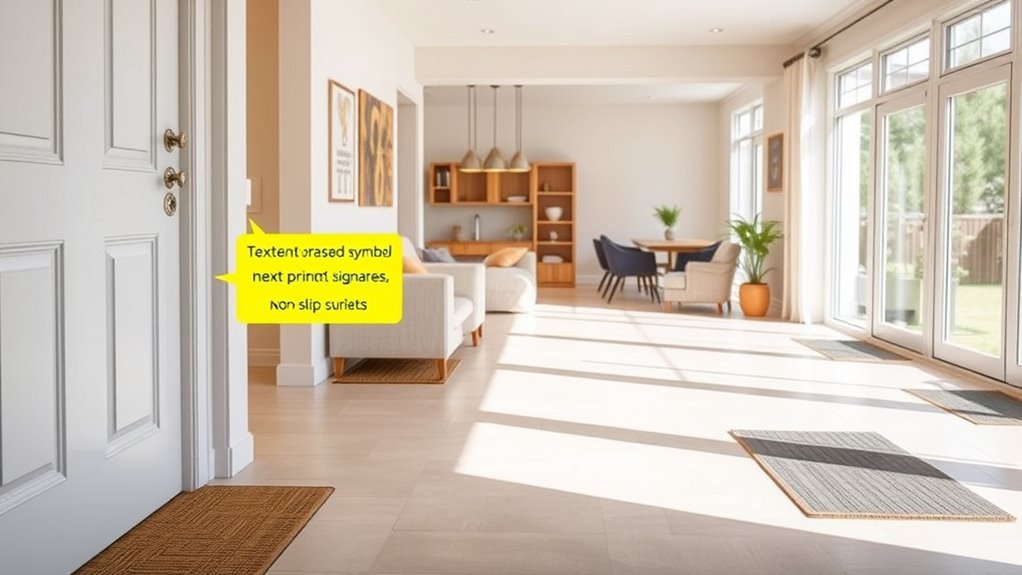
Using tactile cues and clear signage considerably improves safety and independence for individuals with vision or hearing impairments.
Tactile cues and clear signage enhance safety and independence for individuals with impairments.
Tactile cues, such as textured stickers, tactile markers, and textured labels, help identify household items and navigate your home confidently. By adding tactile labels to switches, appliances, and medication bottles, you enable quick recognition through touch, reducing errors and accidents. Incorporating accessible design principles into your home setup can further enhance overall usability and safety. Incorporating self-watering plant pots into your home can also reduce the need for frequent watering, making plant care more manageable for individuals with limited mobility or sensory challenges.
Additionally, incorporating universal design concepts ensures that your home remains functional for everyone, regardless of their sensory abilities. Clear signage with high-contrast print and tactile elements ensures easy recognition and wayfinding. Consistent placement of tactile markers and simple signage creates a reliable system that supports safe navigation and efficient task completion. Implementing assistive technologies can also provide additional support for daily activities and independence.
Adapting Key Areas: Kitchen, Bathroom, and Stairways
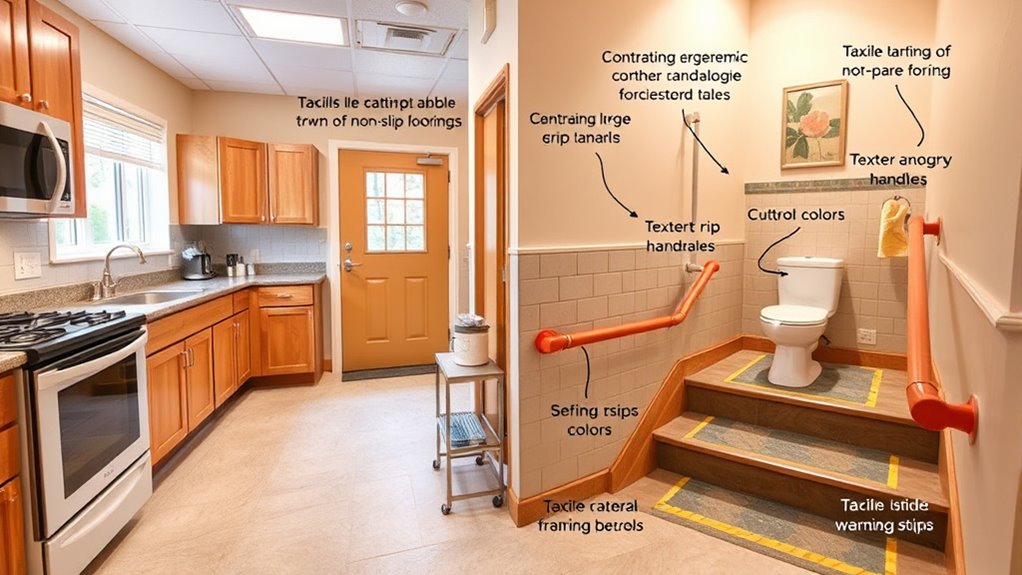
Focusing on key areas like the kitchen, bathroom, and stairways can markedly boost safety and independence for those with vision or hearing impairments. You can improve the environment by implementing contrast, tactile cues, and proper lighting.
For example, consider:
- Installing contrasting grab rails, non-slip flooring, and tactile labels on fixtures and appliances.
- Highlighting stair edges with contrasting nosings or tape and adding sturdy, tactile handrails.
- Using contrast-colored surfaces and tactile markers on switches and dials to aid object recognition and operation.
- Incorporating assistive technology such as talking devices or sensor-activated lighting to further enhance safety and usability. Incorporating personality traits like attention to detail can aid in selecting the most effective modifications for individual needs.
These modifications reduce tripping hazards and help identify key fixtures, ensuring safer navigation. Proper lighting enhances visibility, while tactile cues and contrasting features create a safer environment, promoting confidence and independence in daily activities.
Installing Safety Devices and Accessibility Features
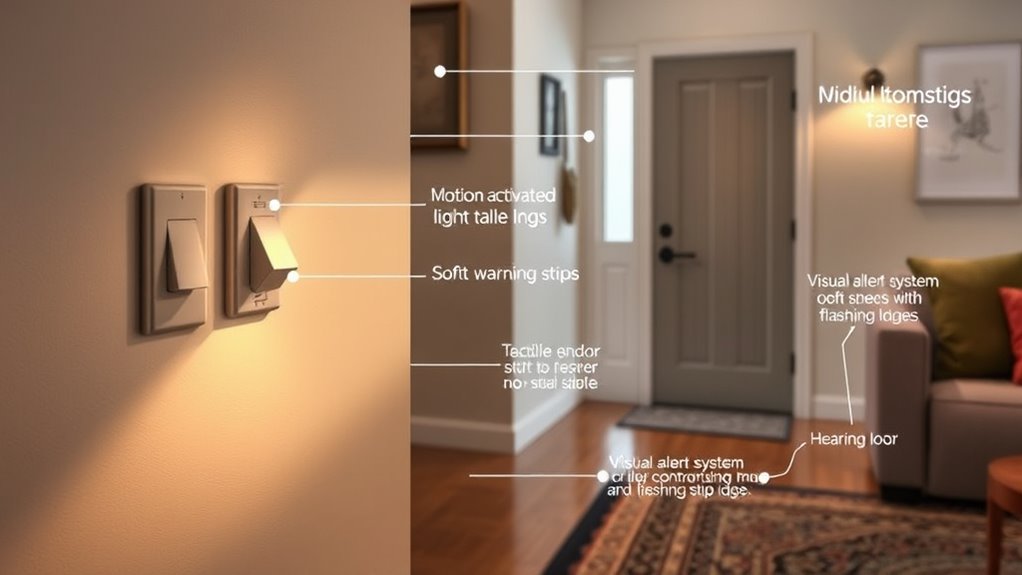
Installing safety devices and accessibility features is essential for creating a secure and independent living environment for those with vision or hearing impairments. Use contrast to highlight hazard zones, such as contrasting nosings on stairs and contrasting-colored handrails to improve visibility. Bright, reflective tape on door edges, switches, and other features enhances detection in low-light conditions. Motion-activated or tactile doorbells and alarm systems provide accessible alerts without relying on visual cues. Audible safety devices like talking smoke alarms and vibrating alerts help detect emergencies for individuals with hearing loss. Incorporate tactile markings on electrical controls and appliances to facilitate safe operation. Additionally, utilizing privacy policies with antimicrobial and calming properties can support overall well-being and reduce stress for residents. Employing industry trends in safety technology ensures your home stays up-to-date with the latest accessible solutions. These safety devices and accessible features work together to reduce hazards, improve detection, and promote independence in your home.
Frequently Asked Questions
How Do You Adapt Activities for Visual Impairment?
When adapting activities for visual impairment, you should use high-contrast colors and tactile markers to make objects distinguishable.
Simplify tasks by labeling items with large, clear labels and keeping them in consistent places.
Incorporate auditory cues and verbal instructions to guide and engage.
Adjust lighting to reduce glare, and consider using assistive devices like talking gadgets or magnifiers to help you stay independent and safe during activities.
How Do You Accommodate Visually Impaired?
Imagine guiding someone through a maze with clear, bold signs at every turn. To accommodate someone with a visual impairment, you use high-contrast colors, large-print labels, and tactile markers to make their journey safer and more predictable.
You enhance lighting, reduce glare, and create consistent arrangements, like familiar landmarks. These steps act as a map, helping them navigate confidently and feel more independent in their environment.
What Is It Like to Live With Visual Impairment?
Living with visual impairment means you often face challenges recognizing objects, reading, and safely maneuvering spaces.
You might rely on assistive devices like canes or electronic aids, and environmental changes such as better lighting or contrasting colors help you.
It can be frustrating or isolating at times, but with support and adaptations, you find ways to stay independent, access information, and enjoy daily activities despite the limitations.
How to Prepare a House for a Blind Person?
You prepare your house by making it safe, accessible, and familiar. You install tactile and high-contrast labels, keep pathways wide and obstacle-free, and add textured flooring and contrasting colors at key points.
You include auditory cues like talking devices and doorbells, and you organize furniture consistently. These steps create a welcoming environment, fostering independence and confidence, so the blind person feels secure and comfortable orienting themselves in their home every day.
Conclusion
By blending beneficial modifications with thoughtful touches, you create a safe, supportive space that welcomes everyone. Brighten your home with better lighting, boost safety with strategic signage, and build comfort with tactile cues. When you adapt areas like kitchens and stairways, you foster independence and peace of mind. Remember, small steps make a significant difference—so start simple, stay sensitive, and make your space a sanctuary for all.









